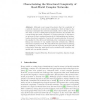Free Online Productivity Tools
i2Speak
i2Symbol
i2OCR
iTex2Img
iWeb2Print
iWeb2Shot
i2Type
iPdf2Split
iPdf2Merge
i2Bopomofo
i2Arabic
i2Style
i2Image
i2PDF
iLatex2Rtf
Sci2ools
COMPLEX
2009
Springer
2009
Springer
Characterizing the Structural Complexity of Real-World Complex Networks
Although recent research has shown that the complexity of a network depends on its structural organization, which is linked to the functional constraints the network must satisfy, there is still no systematic study on how to distinguish topological structure and measure the corresponding structural complexity of complex networks. In this paper, we propose the first consistent framework for distinguishing and measuring the structural complexity of real-world complex networks. In terms of the smallest d of the dK model with high-order constraints necessary for fitting real networks, we can classify real-world networks into different structural complexity levels. We demonstrate the approach by measuring and classifying a variety of real-world networks, including biological and technological networks, small-world and non-small-world networks, and spatial and non-spatial networks.
COMPLEX 2009 | Complex Networks | Real-world Networks | Structural Complexity | Theoretical Computer Science |
| Added | 26 May 2010 |
| Updated | 26 May 2010 |
| Type | Conference |
| Year | 2009 |
| Where | COMPLEX |
| Authors | Jun Wang, Gregory M. Provan |
Comments (0)

